Developmental psychology is the scientific study of how and why human beings change over the course of their lives. Originally concerned with infants and children, the field has expanded to include adolescence, adult development, ageing, and the entire lifespan. Developmental psychologists aim to explain how thinking, feeling, and behaviours change throughout life. This field examines change across three major dimensions: physical development, cognitive development, and social emotional development. Within these three dimensions are a broad range of topics including motor skills, executive functions, moral understanding, language acquisition, social change, personality, emotional development, self-concept, and identity formation.
Source: Wikipedia — Development psychology.
Horizontal and vertical adult development
There are two kinds of growth that we associate with adult development: vertical and horizontal. While both are important, they are very different. If horizontal development is concerned with content and what we know, vertical development is concerned with how we know it. As Cook-Greuter [Susanne Cook-Greuter — see below] describes it, horizontal development is the gradual accumulation of new knowledge, new skills and experience, which can occur without any fundamental change in the individual’s overall meaning making, epistemology or worldview. Vertical development on the other hand, which is a much rarer form of development, entails a complete transformation in the individual’s meaning-making and in their overall view of reality that in turn transforms what they think, how they feel and what they do.
Source: Transformation in Leadership, Part 1: A Developmental Study of Warren Buffett, by Edward J. Kelly, on Integral Leadership Review website.
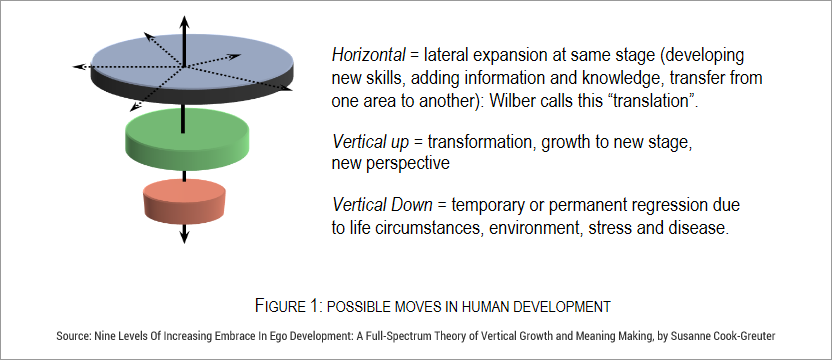
The notables
Erik Erikson ♦
Jane Loevinger ♦
Susanne Cook-Greuter ♦
Bill Torbert & David Rooke
Robert Kegan ♦
Clare Graves ♦
Don Beck & Chris Cowan
Ken Wilber
Frederic Laloux
The symbol ♦ indicates developmental psychologist. The others are closely associated with the developmental psychology field.NEO-PSYCHOANALYTIC SCHOOL

Erik Erikson (1902 – 1994) was a German-American developmental psychologist and psychoanalyst known for his theory about the eight stages of psychosocial development of human beings. Erik Erikson should not be confused with psychiatrist and psychologist Milton Erickson.
The eight stages
- Hope: basic trust vs. basic mistrust
- Will: autonomy vs. shame
- Purpose: initiative vs. guilt
- Competence: industry vs. inferiority
- Fidelity: identity vs. role confusion
- Love: intimacy vs. isolation
- Care: generativity vs. stagnation
- Wisdom: ego integrity vs. despair
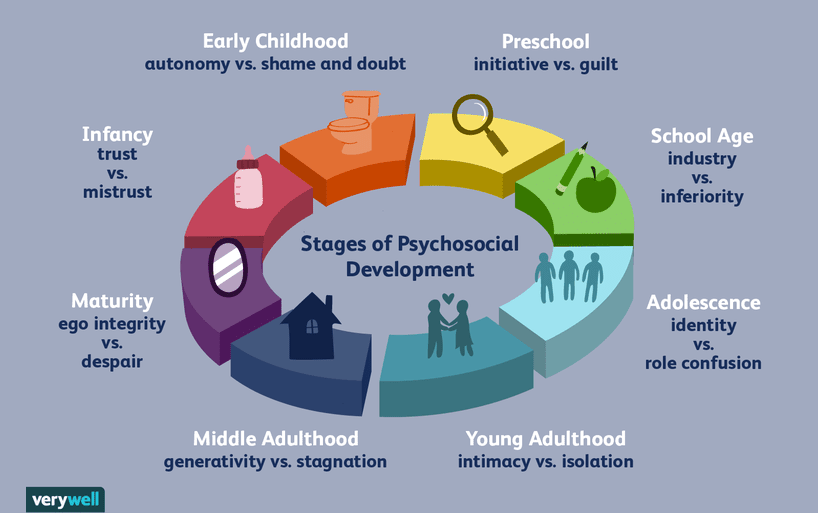
Source: see below.
Erikson’s research suggests that each individual must learn how to hold both extremes of each specific life-stage challenge in tension with one another, not rejecting one end of the tension or the other. Only when both extremes in a life-stage challenge are understood and accepted as both required and useful, can the optimal virtue for that stage surface. Thus, ‘trust’ and ‘mis-trust’ must both be understood and accepted, in order for realistic ‘hope’ to emerge as a viable solution at the first stage. Similarly, ‘integrity’ and ‘despair’ must both be understood and embraced, in order for actionable ‘wisdom’ to emerge as a viable solution at the last stage.
Source: Wikipedia (see below)
A proposed ninth stage
Aged 92, Erikson’s wife and collaborator Joan Erikson wrote that “old age in one’s eighties and nineties brings with it new demands, reevaluations, and daily difficulties” and said that addressing these new challenges requires “designating a new ninth stage”. She remarked that all eight stages “are relevant and recurring in the ninth stage” and that the psychosocial crises of the eight stages must be faced again, but with the quotient order reversed.
The term “quotient order reversed” signals a shift in focus: instead of primarily striving for resolution in favour of the positive pole, older adults may find themselves more deeply confronting the struggles or unresolved aspects of the earlier crises. This reversal aligns with the increased complexities, vulnerabilities, and introspections of late life.
In the first paragraph, the quoted text is excerpted from The Life Cycle Completed: Extended Version (Erik H. Erikson, Joan M. Erikson, 1998). Most of the rest came from Wikipedia. ChatGPT conjured up the second paragraph – a tad pretentious perhaps but question answered.
Read more about Erik Erikson and the Stages of Psychosocial Development
Erikson’s Stages of Development, on VeryWell Mind website (the source of the earlier image)

Originator of ego development theory.
Jane Loevinger Weissman (February 6, 1918 – January 4, 2008) was an American psychologist. Born the third out of five children born into an Jewish American family, the daughter of Gustavus Loevinger and Millie Strause. She was a developmental psychologist who developed a theory of personality which emphasized the gradual internalization of social rules and the maturing conscience for the origin of personal decisions. She also contributed to the theory of measurements by introducing the coefficient of test homogeneity. In the tradition of developmental stage models, Loevinger integrated several “frameworks of meaning-making” into a model of humans’ constructive potentials that she called ego development (or in German, Ich-Entwicklung). The essence of the ego is the striving to master, to integrate, and make sense of experience. She also is credited with the creation of an assessment test, the Washington University Sentence Completion Test.
Source: Wikipedia—Jane Loevinger
Read more about Jane Loevinger and ego development theoryEgo development stages
- E1 is the pre-social stage.
- E2 is the impulsive, egocentric stage of early childhood: the child lives in the present; is preoccupied with physical needs and impulses; is demanding; and is dependent on others for control. The child evaluates everything as simply “good” or “bad” and has a poor understanding of rules and causation. There is a merger of physical and emotional symptoms with little inner life.
- E3 is the self-protective stage: the child is wary and self-protective, is able to delay immediate gratification, and has the beginnings of impulse control and a self-serving awareness of rules. Interpersonal skills are used to exploit others. The child loves rituals, traditions, rules, and controls and understands that it is usually best to follow rules. Adults stalled in E3 may be deceptive or opportunistic.
- E4 is the conformist stage of early adolescence. Teens conform to societal norms and seek close friends similar to themselves.
- E5 is the self-awareness stage. It is conscientious/ conformist, with increased awareness of self and a breaking with one’s peer group. It is characterized by self-examination, recognition of alternatives, qualification of choices, loneliness and self-consciousness, an increased inner life, and an experiencing of relationships as feelings.
- E6 is the conscientious stage, in which the adolescent or adult abandons convention for internal standards and long-term goals, and ideals. Judgments and decisions are based on personal feelings. Guilt comes from hurting others rather than from breaking rules. People in E6 experience vivid inner states and individual differences and feel overly responsible for others. According to Loevinger, few adults make it beyond E6.
- E7 is the individualistic stage, in which there is an emergence of individuality; more tolerance for individual differences; a distinction between inner and outer states; and deeper, more intense relationships.
- E8 is the autonomous stage, in which the search for self-fulfillment replaces striving to achieve. There is increased recognition of the complexity of people and situations; increased respect for others and their need for autonomy; tolerance for ambiguity and paradox; and increased focus on psychological causation and development.
- E9 is the integrated stage, is a theoretical peak that is rarely achieved. It is similar to Abraham Maslow’s self-actualization, with the complete integration of identity and individuality.
- E10 is the flowing stage.
Main source: Reference Encyclopedia
Jane Loevinger profile (extensive) on Psychology’s Feminist Voices website

Dr Susanne R. Cook-Greuter is a leading figure in the field of ego development theory, her work building on that of Jane Loevinger. Cook-Greuter has worked closely with Robert Kegan (see below), and with Bill Torbert (see below also), with whom she developed the Leadership Development Profile, an instrument that assesses the core human process of meaning making. She is a founding member of Ken Wilber’s Integral Institute and prominent in the wider Integral community. She sees herself as a benevolent skeptic of all the certainties and beliefs espoused in the field of vertical development and in other transformational approaches. Cook-Greuter is a strategic advisor to Vertical Development Academy (VeDA), serving as its research director, and is the creator of MAP, VeDA’s Maturity Profile. Her theoretical work forms the foundation for VeDA’s approach to enabling transformative leadership.
Compiled by Jack Martin Leith from multiple sources.
What is Ego?
First, what do I mean by ego? As I define it in ego development theory, ego underlies the universal drive to explain everything and make us feel safe, important, and to belong. Ego represents the striving of human beings to understand themselves and the world they live in. It is the tireless organizer, interpreter, and synthesizer of experience. Its task is to turn experience into a coherent narrative about the world. How does it do that? It does so by telling a culturally influenced story about who we are, why we are here and for what purpose.
Overall, the ego labors mightily to create and maintain meaning and vigorously defends against dissonant information and its deep, unspeakable sense of helplessness. Indeed, when we are not able to tell a good story about ourselves and our tribe, we feel anxiety and despair. Ego is invested in the denial of death, and in upholding the illusion of our immortality. Therefore, facing and embracing our finitude is part of late-stage realization.
The Construct-Aware Stage of Ego Development and its Relationship to the Fool Archetype (pdf) by Susanne Cook-Greuter
This description of the ego is consistent with Iain McGilchrist’s account of the brain’s left hemisphere workings; similarly the explanation of the tonal given to Carlos Castaneda by his teacher don Juan Matus.
Susanne Cook-Greuter’s Ego Developmental Model
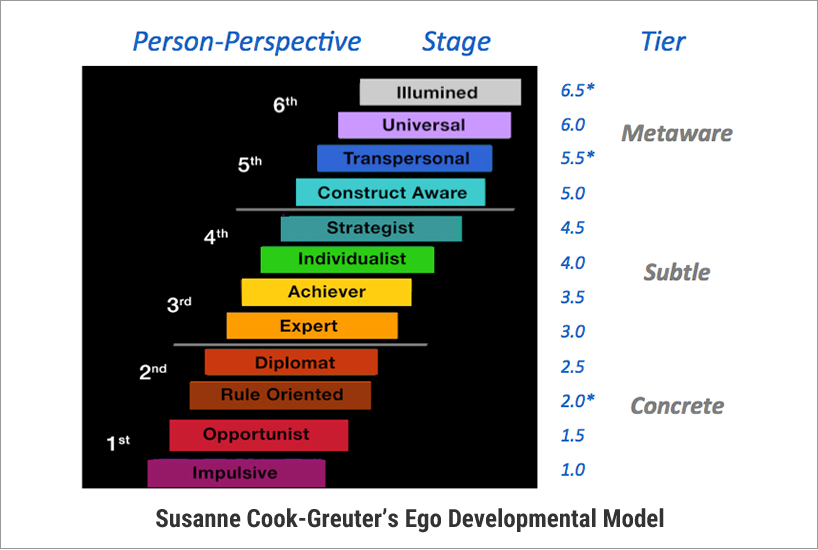
Detailed exposition: The Nine Stages of Increasing Embrace in Ego Development Theory, by Susanne R. Cook-Greuter (pdf)
Construct-Aware folks are the first who potentially realize the illusion of ‘knowing’ and the futility of trying to make ever better maps of reality.
Susanne Cook-Greuter, The Construct-Aware Stage of Ego Development and its Relationship to the Fool Archetype (pdf) in Integral Review, August 2018. Vol. 14, No.1
Susanne Cook-Greuter and Ego Development Psychology
View 24 slides:
Read more about Susanne Cook-Greuter and her work
The Construct-Aware Stage of Ego Development and its Relationship to the Fool Archetype (pdf) by Susanne Cook-Greuter, in Integral Review, August 2018. Vol. 14, No.1
Ego Development: A Full-Spectrum Theory of Vertical Growth and Meaning Making (pdf, not paywalled) by Susanne Cook-Greuter
Exploring the paradoxical role and experience of fallback in developmental theory (pdf) by Valerie Townsend Livesay, Ph.D.
Michael Rucker discusses about fun and the ego with Susanne Cook-Greuter
The Nine Stages of Increasing Embrace in Ego Development Theory, by Susanne R. Cook-Greuter (pdf)

Bill Torbert and David Rooke are the co-originators of Action Logics, a leadership development framework devised in collaboration with Susanne Cook-Greuter.
Bill Torbert, Professor Emeritus of Leadership at Boston College, has spent his career leading, consulting, teaching and researching, focusing on Collaborative Developmental Action Inquiry applied to personal, organisational and scientific development. Since his retirement from academia in 2008, he has continued his work through Global Leadership Associates, the Amara Collaboration, the Global Leadership Profile, Alchemists’ Workparties, and his informal action inquiry community.
David Rooke co-founded Harthill, a UK-based consulting firm, in 1985. He has published several books including Personal and Organisational Transformations and is the co-author, with Bill Torbert, of the award winning Harvard Business Review article Seven Transformations of Leadership (subscription / limited access).
Read more: The Leadership Development Profile, on the website of Cleveland Consulting GroupThe seven action logics:
Opportunist A leader who wants to win in any way possible, is self-oriented and manipulative, believes that “might makes right,” and views emergencies and competitive opportunities; 4 percent profiling at action logic.
Diplomat A leader who needs to belong, avoids overt conflict, follows group norms, enjoys routine work, enforces standards, and helps bring people together; 11 percent profiling at action logic.
Expert A leader who values logic, expertise and problem-solving, seeks rational efficiency, feels unique, is a perfectionist, and improves efficiencies; 37 percent profiling at action logic.
Achiever A leader who focuses on accomplishing long-term goals, delegates effectively, balances managerial duties and external demands, works on day-to-day improvements, and stresses action and goal achievement; 30 percent profiling at action logic.
Individualist A leader who adopts a relativistic perspective, is aware of emotions and self-expressions, is non-judgmental, enjoys working independently, and drives change; 11 percent profiling at action logic.
Strategist A leader who engages value action inquiry, fosters mutuality and autonomy, interweaves short- and long-term goals, is aware of paradoxes, can handle multiple roles, and supports transformational change; 5 percent profiling at action logic.
Alchemist A leader who integrates material, spiritual, and societal transformation; 2 percent profiling at action logic.
Source: CIO Wiki — Action Logic.
CONSTRUCTIVE DEVELOPMENT SCHOOL

Originator of Constructive Development Theory.
Wikipedia—Constructive developmental framework
Robert Kegan (born August 24, 1946) is an American developmental psychologist, author, and consultant. He is a licensed psychologist and practising therapist, has lectured widely to professional and lay audiences, and consults in the area of professional development and organization development. He was the William and Miriam Meehan Professor in Adult Learning and Professional Development at Harvard Graduate School of Education, where he taught for forty years until his retirement in 2016. He is the author or co-author of several books, notably The Evolving Self, In Over Our Heads, Immunity to Change, and An Everyone Culture.
Source: Wikipedia—Robert Kegan
According to the developmental psychologist Robert Kegan, a person’s self-concept evolves in a series of stages through their lifetime. Such evolution is driven alternately by two main motivations: that of being autonomous and that of belonging to a group. Human beings are “controlled” by these motivations in the sense that they do not have influence on them but are rather defined by them. Additionally, these motivations are in conflict and their relationship develops over a lifespan
Kegan describes five stages of development, of which the latter four are progressively attained in adulthood, although only a small proportion of adults reach the fourth stage and beyond:
Stage 1: Purely impulse or reflex-driven (infancy and early childhood).
Stage 2: The person’s sense of self is ruled by their needs and wishes. The needs and wishes of others are relevant only to the extent that they support those of the person. Effectively the person and others inhabit two “separate worlds” (childhood to adolescence).
Stage 3: The person’s sense of self is socially determined, based on the real or imagined expectations of others (post-adolescence).
Stage 4: The person’s sense of self is determined by a set of values that they have authored for themselves (rarely achieved, only in adulthood).
Stage 5: The person’s sense of self is no longer bound to any particular aspect of themselves or their history, and they are free to allow themselves to focus on the flow of their lives.
Source: Dante-Gabryell Monson, on Google Groups | view source
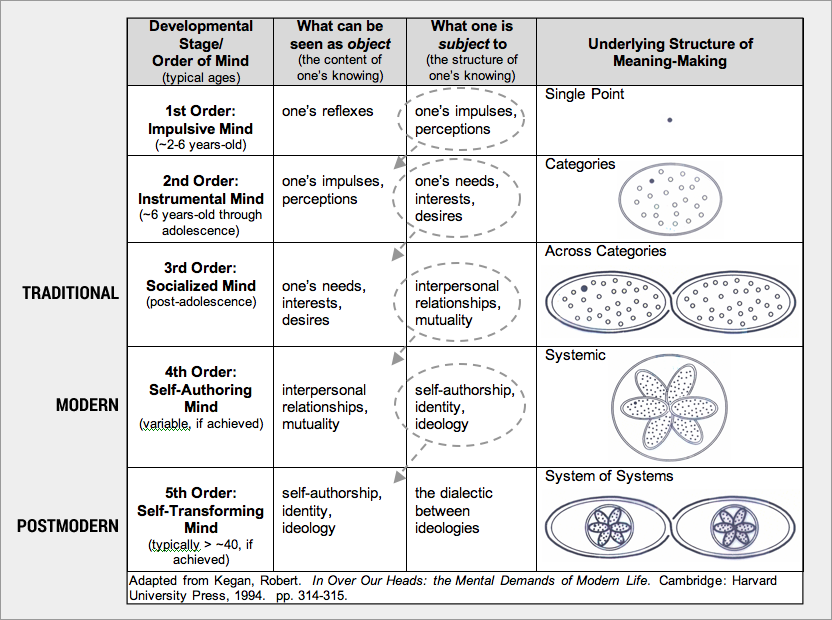
Adapted from In Over Our Heads: the Mental Demands of Modern Life, by Robert Keegan, Harvard University Press (originator unknown).
Read more about Robert KeganGRAVESIAN SCHOOL

Clare W. Graves (December 21, 1914 – January 3, 1986) was a professor of psychology and originator of the emergent cyclical theory of adult human development [The Emergent, Cyclical, Double Helix Model of the Adult Human Biopsychosocial Systems Development, a.k.a. The Theory of Levels of Existence], aspects of which were later popularised as Spiral Dynamics.
In 1975, Don Edward Beck [see below], a professor at North Texas University, sought Graves out on the basis of his 1974 article in The Futurist. By this point, Graves’s health was declining, and Beck resolved to record Graves’s knowledge. They were later joined by Christopher Cowan [see below also], with whom Beck developed Spiral Dynamics as an extension of Graves’s work. After Graves’s death, Cowan, his consulting partner Natasha Todorovic, and archivist William R. Lee, became custodians of Graves’s work, maintaining the official Clare W. Graves website, which provides access to some of those materials.
While sometimes cited in the context of developmental psychology, Graves is not broadly influential within developmental psychology academia. Graves has been criticized for not fully publishing his theory and data, with one source observing that by “leaving his legacy in not-quite-finished form, and in cultivating followers who have elaborated his ideas leaving them essentially unquestioned, [Graves] appears to have succeeded in leaving us a provocative and important theory, while so far avoiding anything like a debate about its merits¹.
Source: Wikipedia — Clare W. Graves
1. Jump down the page to Was Graves’ research methodology rigorous?
Clare Graves’s theory holds that human beings develop through a series of “levels of existence”.Background on Clare W. Graves
“What is the psychologically Mature Adult Human Personality in operation?” This is the question Dr. Clare Graves proposed to his research participants in well-designed study spanning decades and still ongoing today.
Graves worked on his master’s and doctorate during World War II when professors were frequently called away for military service and replaced by whoever was available. This was a time when cross-disciplinary studies were rare. However, due to the continual replacement of teachers at Western Reserve, Graves was exposed to a much larger number of teachers from varied disciplines than was usual at that time, including biology, anthropology, philosophy, and sociology. (Todorovic, Evolution of the Graves Models, Recorded lecture, 2016) Clare Graves later taught psychology at Union College in Schenectady, New York, from 1948 to 1978, and covered the various psychology theories he had learned as a graduate student including those by Pavlov, Skinner, Erikson, Freud and Jung. His students were often baffled by these disparate views and frequently asked him which theory of psychology was right. It niggled him that he didn’t have a clear answer to give.
Graves was also concerned that, with the exceptions of Jung and Frankl, most psychological theories failed to integrate the objective with the subjective and also didn’t include a cohesive model of the hierarchical development of the brain in the development of cognitive processing. (Graves, The Never Ending Quest, 2005, pp. 36-37.)
Source: Comparison of Clare Graves with other Developmental Theorists (background for Spiral Dynamics®), by Beth O’Hara, on Conscious Living Center website.
Proponents have referred to the levels in the following ways among others:
vMemes / value memes (Beck and Cowan)
Valuing systems
Belief structures
Organising principles
Worldviews
Mindsets
Ways of thinking
Modes of adjustment
Levels of consciousness (Wilber)
Waves (Wilber)
Stages / development stages
Orders
Behavioural states
Altitudes of development
Theoretical containers
Each level transcends and includes the lower levels. Levels cannot be skipped.
Graves’ double helix

The two tables displayed below provide an outline of Graves’s theory. Each level is designated by two letters, one for each helix. The first letter (in the range A to H) refers to the external life conditions the person or group encounters, and the second (N to U) refers to the internal brain/mind capacities available to cope with such conditions.
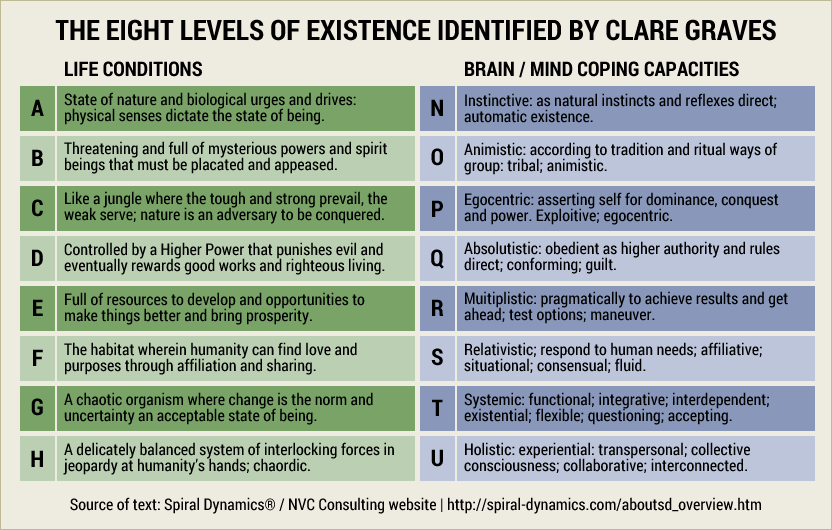
Source of text: Spiral Dynamics® / NVC Consulting website.
Chris Cowan and Don Beck, the originators of Spiral Dynamics (see later section), replaced Graves’ two-letter scheme with a set of random colours, which I have added to the first column of the table below. Ken Wilber subsequently changed some of the colours so that together they resemble a spectrum, and his designations, which were later adopted by Frederic Laloux, are shown in brackets.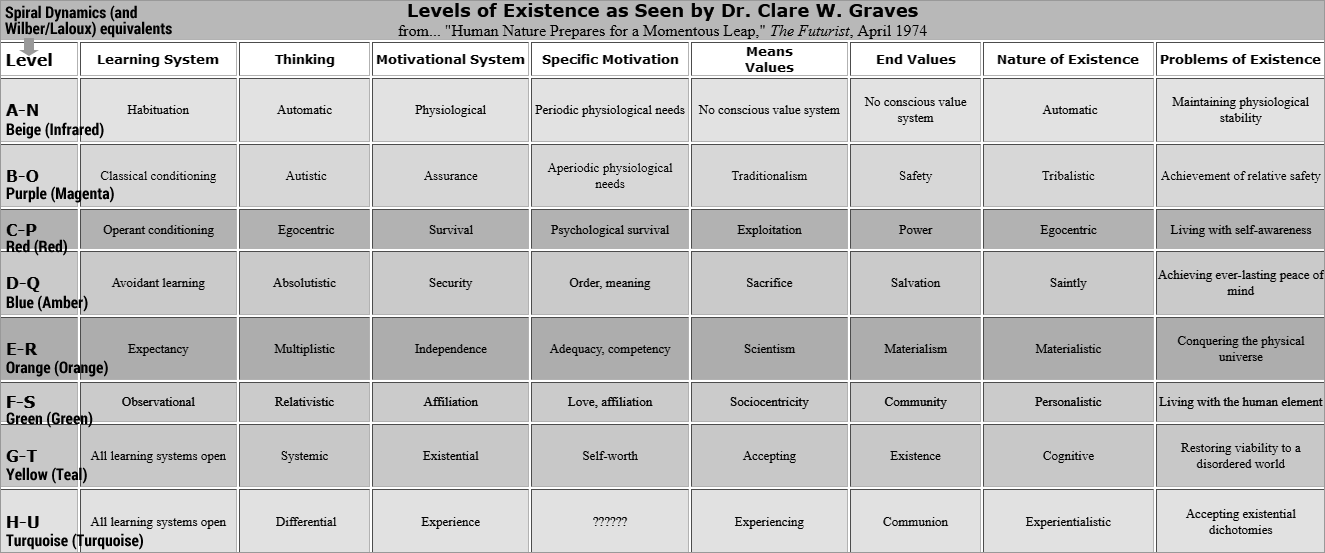
Levels of Existence as seen by Dr. Clare W. Graves | Source: Human Nature Prepares for a Momentous Leap, The Futurist, April 1974 via Dr. Clare W. Graves legacy website | Click on image to enlarge
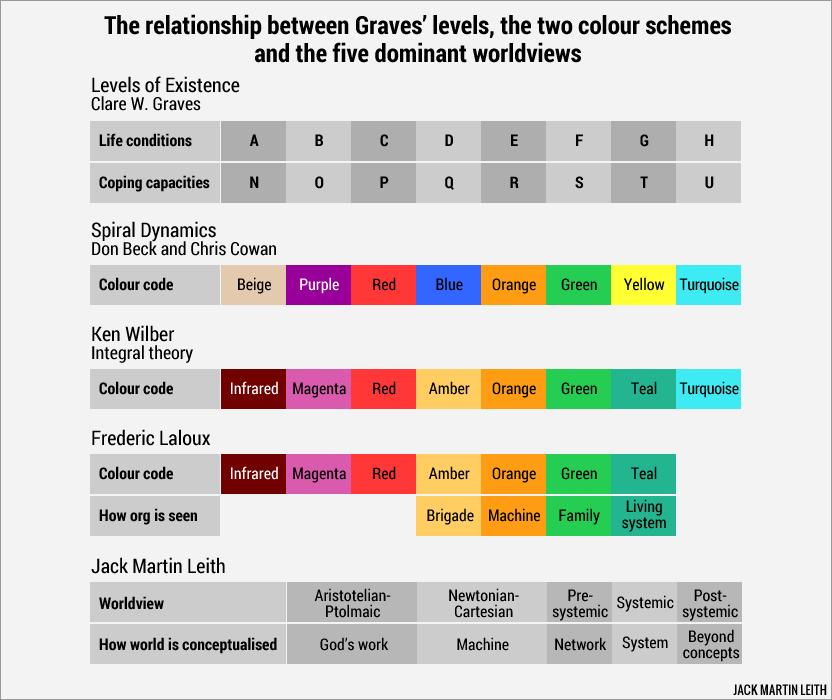
Was Graves’ research methodology rigorous?
It is irrelevant whether the SD model (or its integral stripped-down version) correspond with other models. This is a game that academics like to play, but not a meaningful one. What is relevant is a) was Graves research good and b) does the model work. For the former it is a pity that most commentaries are based on second-hand, third-hand or thoroughly misrepresented versions of the Graves model. The research methodology is, by any academic and scientific standards, exemplary. The fact that no one else has corroborated it does not invalidate it. And does the model work? The answer is yes. It is predictive (Graves described today’s life conditions accurately in 1984). Is it explanatory? Yes, to a high degree. Can it be applied in practice to diagnosis and intervention? Yes again. Many examples are provided in the books edited by Tom Christensen (integral publishers) and in the new “Spiral Dynamics in Action” by Beck, Viljoen and others. There are Ph.D theses by Lorraine Laubscher, Bjarni Jonsson and others that provide evidence in academic form.
Source: Jon Freeman, one of the UK’s leading authorities on Graves’ work and Spiral Dynamics, commenting here.
Read more about Clare Graves and his workGiven the scope, influence, and extensive peer validation of Graves’s work, why is Clare Graves’s work not widely accepted in the field of developmental psychology? Is it because the model is so complex and encompassing, it is difficult for many to understand how to implement it? Is it because authors such as Ken Wilber have popularized a diluted and distorted version? Or perhaps because Graves was only published posthumously and never in peer-reviewed scientific journals? Regardless, the work of Clare W. Graves deserves a prominent place in the field of developmental psychology based on the validity and scope of his research.
Source: Comparison of Clare Graves with other Developmental Theorists (background for Spiral Dynamics®), by Beth O’Hara, on the Conscious Living Center website | Includes a description of Graves’ research methodology.
Dr. Clare W. Graves legacy website
Don Beck, Chris Cowan and Spiral Dynamics®

Don Beck and Chris Cowan built on the work of Clare Graves and named their approach Spiral Dynamics®, which they introduced in 1996.
Don Edward Beck (January 31, 1937 – May 24, 2022) was an American teacher, geopolitical advisor, and theorist who focused on applications of large scale psychology, including social psychology, evolutionary psychology, organizational psychology and their effect on human sociocultural systems. He was the co-author of the Spiral Dynamics theory, an evolutionary human development model adapted from the work of his mentor and colleague, developmental psychologist Clare W. Graves, Professor Emeritus in Psychology at Union College in New York, with whom he worked for over a decade.
Source: Wikipedia—Don Edward Beck
I found Chris [Cowan] a beneficent mentor, generous in the amount of time he gave and his readiness to share his knowledge and understanding. What was particularly discerning in Chris’ approach was his willingness to challenge givens and to demand evidence for assumptions if they were to be accorded credibility. Often executed with a knowing and wicked humour! In particular he was scathing about Beck’s Spiral Dynamics integral, the self-declared ‘third phase’ of the Gravesian approach. While for many years Don was careful neither to endorse nor refute the ‘spiritual’ embellishments Wilber ascribed to 2nd Tier thinking (and Wilber’s claims about ‘3rd Tier’!), Cowan was mischievously ruthless in dismissing them as ‘woo woo’! As post-split relations worsened between them, Chris particularly delighted in picking up on Don’s increasing dismissal of the need to distinguish conceptually between meme and vMEME. Beck’s view seemed to be that this was quibbling over semantics; but, as somebody with one foot in the world of academia, I felt Chris was right: it was important to be precise in our terminology if we were to gain academic credibility.
Source: Fare Thee Well, Christopher Cowan, by Keith E. Rice, on Keith E. Rice’s Integrated SocioPsychology Blog & Pages.
Not a typology
The spiral/Graves model is not a typology for categorizing people into seven or eight rigid boxes; it’s not that simple. These are ways of thinking about a thing that resides in varying proportions within human beings and which ebb and flow within us; they are not labels for kinds of human beings. We move into and out of them. They can coexist within us, though we tend to find a zone of comfort that works so long as conditions remain unchanged. This explains why the spiral model is an emergent sequence and not a developmental stair step tied to age. There is no mandate for movement, nor for stagnation; and no predictable timeline when there is or isn’t change, only a probable sequence as we move forward or back in our search for balance and congruence with our worlds.
So, the question is not how to deal with a ‘kind of person,’ or even with people at a given level; the question is how to deal with the thinking of the level when it is activated in its particular way within the particular person. While most of us operate with mixtures and blends of these colors to some extent, one or two are often dominant.
Source: Spiral Dynamics / NVC Consulting official website.
The psychology of the mature human being is an unfolding, emergent, oscillating, spiraling process marked by progressive subordination of older, lower-order behavior systems to newer, higher-order systems as man’s existential problems change.
Source: Dr. Clare W. Graves.
Clare Graves devised a double helix, with one helix representing external life conditions (levels A to H) and the other representing internal coping capacities (levels N to U). Don Beck and Chris Cowan collapsed the double helix into a single spiral, as shown in the next image.“The spiral” isn’t a typological model; it’s a way of thinking. The “types of people” school continues to promote this theory as a way to sort everyone into over-simplified categories and rigid boxes. Even worse, a few then offer ways to manipulate people based on those false assumptions. Whether maneuvering people for ostensibly positive or negative reasons, that is still not a proper use because the aspects of human nature this model addresses can change. That is not our approach.
Source: Spiral Dynamics / NVC Consulting official website.
A Spiral vortex best depicts this emergence of human systems as they evolve through levels of increasing complexity, Each upward turn of the spiral marks the awakening of a more elaborated version on top of what already exists. The human Spiral, then, consists of a coiled string of value systems, worldviews, and mindsets, each the product of its times and conditions. In other words, new times produces new minds.
Source: Summary of Spiral Dynamics®, Abstract, on Value Based Management.net website.
Image credit: The Next Evolution | thenextevolution.com/spiral-dynamics

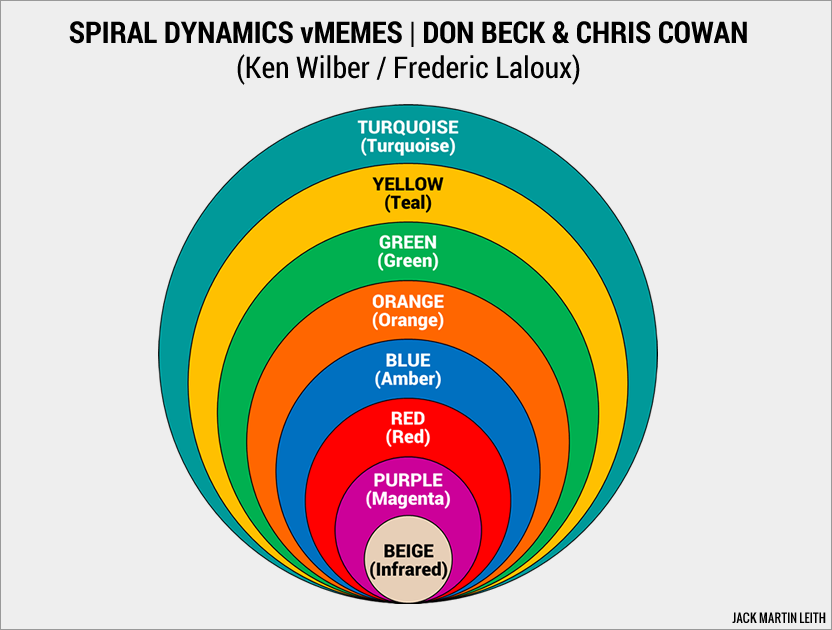
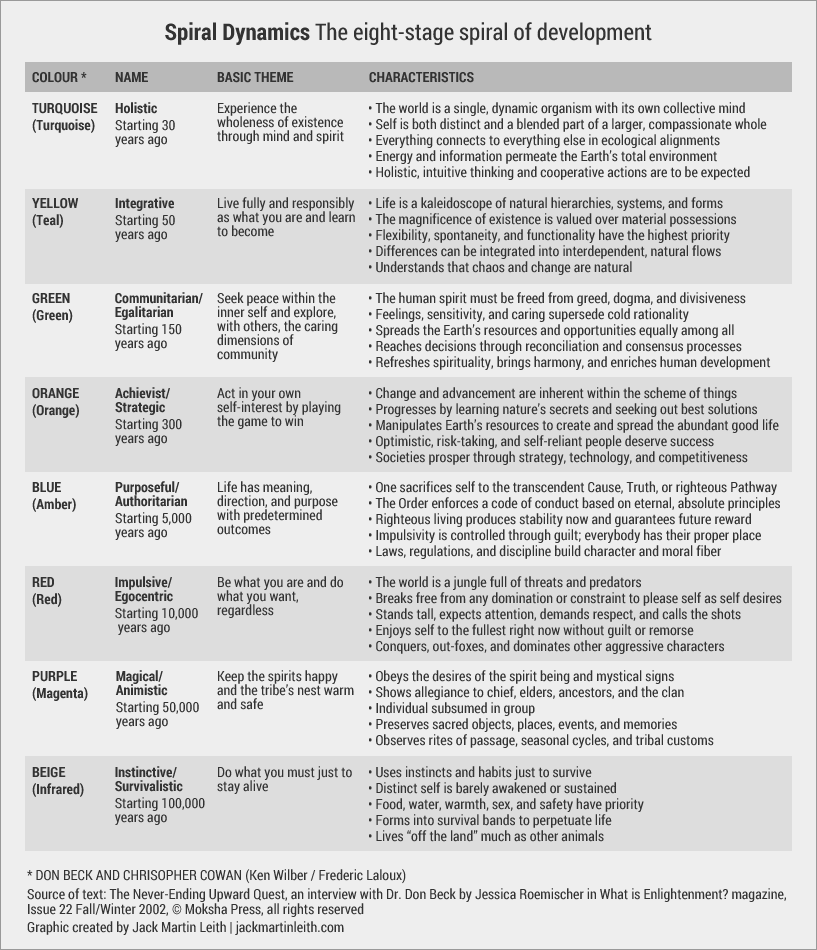
The Spiral Dynamics® vMemes correspond with Susanne Cook-Greuter’s stage divisions.
Read more about Don Beck and Chris CowanThe work of Cook-Greuter, using a research method that is thought to be highly reliable, found, in the realm of self identity, the same sorts of developmental examples as Spiral Dynamics found in the arena of values. In the later stages, as exhibited in a small number of subjects, self identity shifted from a primary concern with one’s identity in the material world, gradually and clearly toward a self identity wherein the primary concern (and indeed, the primary sense of self), was oriented toward the whole of things—the whole of the human race, the whole of the planet, the whole of whatever is in existence.
And though the two bodies of research used different methods and tools, different administrators, different subjects, and in different decades, the data pointed toward comparable conclusions. Indeed the stage divisions articulated in Cook-Greuter’s work were congruent with the stages of Spiral Dynamics. Both consistently reinforced the conclusions of the other, even down to the sequence of stages.
Source: A Summary of Susanne Cook-Greuter’s Developmental Model, by David Yeats, on StillPoint Psychotherapy website.
Fare Thee Well, Christopher Cowan
Read more about Spiral Dynamics
Spiral Dynamics / NVC Consulting official website
Spiral Dynamics in the Integral Age, by Don Beck, on Integral World website
Ken Wilber, AQAL and Spiral Dynamics Integral

Ken Wilber (born 1949) is an American philosopher and the principal developer of Integral Theory, a philosophy which suggests the synthesis of all human knowledge and experience. His books include Integral Psychology, Sex, Ecology, Spirituality, and A Brief History of Everything, which incorporated Beck and Cowan’s Spiral Dynamics as a “core element” alongside his own AQAL (All Quadrants, All Levels) framework. AQAL integrates the modified (controversially) and recoloured Spiral Dynamics system with the Four Quadrants framework illustrated below.
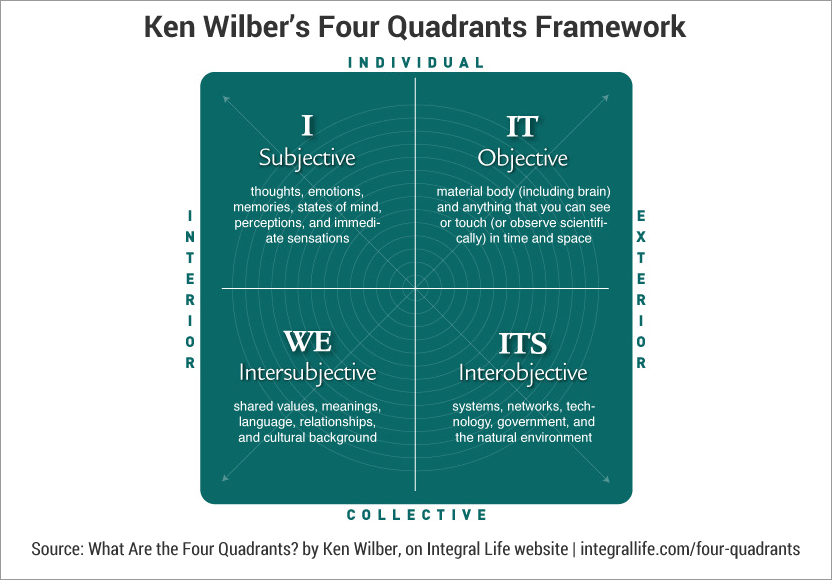
Source: What Are the Four Quadrants? by Ken Wilber, on the Integral Life website.
Starting in 2000, Wilber and Beck collaborated to create Spiral Dynamics Intergal (SDi). But by 2005, Beck’s working relationship with Wilber had collapsed, mainly because Beck felt that Wilber had distorted the Spiral Dynamics / Gravesian model. As a consequence, Wilber abandoned the terms Spiral Dynamics Integral and SDi. A Google search returns few worthwhile results, aside from Spiral Dynamics in the Integral Age, by Don Beck, on the Integral World website, and the website of Spiral Dynamics Integral Nederland.Cowan filed to register “Spiral Dynamics” as a service mark in 1998, while Beck wanted to keep the name open for academic use. The two parted ways in 1999, with Beck continuing to use the Spiral Dynamics name for the next couple of years.
Beck had been drawn to the work of Integral theorist Ken Wilber, whose book A Theory of Everything (2000) incorporated Beck and Cowan’s Spiral Dynamics as a “core element” alongside Wilber’s AQAL framework.
By 2001, Beck began equating NVC with his new Spiral Dynamics Group, which featured early mentions of Spiral Dynamics Integral. In the last weeks of 2001, Beck announced Spiral Dynamics Integral (SDi). In the announcement, he credited Wilber with significantly increasing the level of interest in Spiral Dynamics, and also cited the influence of John Petersen of the Arlington Institute, and Ichak Adizes.
By 2005, Beck’s working relationship with Wilber had also disintegrated as Beck felt that Wilber had distorted the Spiral Dynamics/Gravesian model. Wilber subsequently de-emphasized SDi, and recolored its levels to fit his spiritual emphasis2.
Source: Don Edward Beck—Wikipedia.
2. The reworked colour scheme represents the light spectrum, extending from infrared to ultraviolet. It is not based on the Hindu chakra system.
Read more about Ken Wilber and his work
Download A Summary of My Psychological Model, by Ken Wilber (pdf; 73pp)
View the article: The Rise and Fall of Ken Wilber, by Mark Manson

Frederic Laloux’s next-stage (Teal) organizations
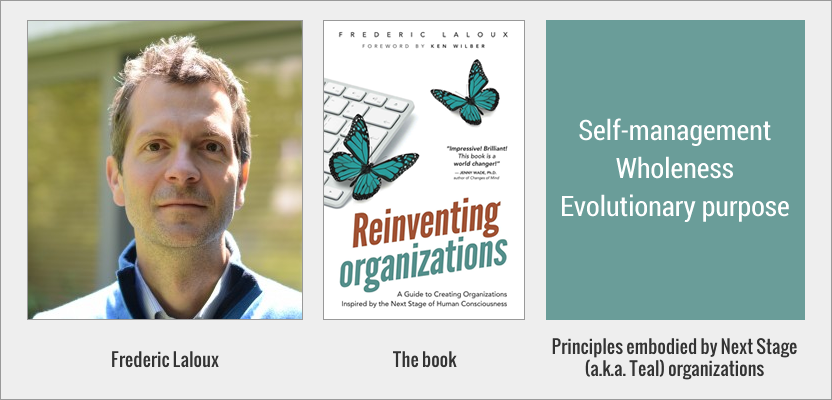
Teal organizations is a concept originated by Frederic Laloux, a Belgian former McKinsey consultant, and introduced in 2014 in his book Reinventing Organizations: A Guide to Creating Organizations Inspired by the Next Stage of Human Consciousness.
Laloux was inspired by Spiral Dynamics and the Ken Wilber variant described earlier, as well as the work of various developmental psychologists including Susanne Cook-Greuter, Robert Kegan and Jane Loevinger.
For an overview of the book, I recommend Reinventing Management — Part 1: What Color Is Your Organization? and Reinventing Management — Part 2: What Happens When No One Is In Charge? by Rod Collins, Director of Innovation, Optimity Advisors, on Huffington Post.
Video: The emergence of a new management paradigm
A talk by Frederic Laloux followed by Q&A (August 2014; runtime 1:42:52)
The 12 next-stage organizations featured in Reinventing Organizations
BSO/Origin
Buurtzorg
ESBZ
Heiligenfeld
HolacracyOne
Morning Star
RHD
Sounds True
Sun Hydraulics
The three core principles of Teal organizations
I’m curious to find out how Frederic Laloux came to choose the three principles or defining characteristics summarised below. What was the larger set from which the three were selected, how was the larger set determined, and by what criteria were the three core principles identified?
For more detail, please download Frederic Laloux “Reinventing organizations”: excerpt and summaries, by Change Factory (pdf)Self-management Teal organizations operate effectively, even at a large scale, with a system based on peer relationships. They set up structures and practices in which people have high autonomy in their domain, and are accountable for coordinating with others. Power and control are deeply embedded throughout the organizations, no longer tied to the specific positions of a few top leaders.
Wholeness Whereas Orange and Green organizations encourage people to show only their narrow “professional” selves, Teal organizations invite people to reclaim their inner wholeness. They create an environment wherein people feel free to fully express themselves, bringing unprecedented levels of energy, passion, and creativity to work.
Evolutionary purpose Teal organizations base their strategies on what they sense the world is asking from them. Agile practices that sense and respond replace the machinery of plans, budgets, targets, and incentives. Paradoxically, by focusing less on the bottom line and shareholder value, they generate financial results that outpace those of competitors.
Source: The Future of Management Is Teal, by Frederic Laloux, in strategy+business.
The sequence of events from Graves to Laloux
Originally, Laloux intended to adopt the Beck and Cowan colour scheme and to write a book about Yellow organizations, but Cowan had died and Beck was unenthusiastic about a collaboration. Laloux turned instead to Ken Wilber, who was happy for Teal organizations to be the focus of the book.Clare Graves created a stage model of human drives in the ’60-’70, which he called the “Levels of Existence”. He did not use colors, but instead codes such as A, B, C. [Two-character codes in fact, as outlined here.] See: Graves, Clare W., “Levels of Existence: An Open System Theory of Values”. Journal of Humanistic Psychology, November 1970.
Don Beck and Chris Cowan popularized this model in Spiral Dynamics: Mastering Values, Leadership and Change (Blackwell, 1996) and added the color names to identify stages: Beige, Purple, Red, Blue, Orange, Green, Yellow, Turquoise and (hypothetically) Coral.
Ken Wilber discovered Spiral Dynamics around 2000 and started a collaboration with Beck (but not with Cowan, who objected to Wilber’s simplifications), which resulted in Spiral Dynamics Integral or SDi. Wilber popularized it in some of his works, e.g. A Theory of Everything (2000) and Integral Psychology (2000).
Wilber and Beck split up and Wilber published a revised and expanded color scheme in his Integral Spirituality (2006): Infra-Red, Magenta, Red, Amber, Orange, Green, Teal, Turquoise, Indigo, Violet, Ultra-Violet and White. The most notable change was Yellow ? Teal, the first of the two Integral stages.
Frederic Laloux used Ken Wilber’s color scheme (most notably the color “Teal”) in his popular book Reinventing Organizations (2014), and NOT the original Spiral Dynamics palette of colors devised by Beck and Cowan (though that seems to have been his original intention). The Wilber community popularized this approach under the umbrella term “Teal Organizations” and “Teal Tribes” and the notion has gained momentum.
There have been two sources of resentment among those who promote the “original” version of Spiral Dynamics: first by Chris Cowan to Wilber’s popularization of Spiral Dynamics and second by Don Beck to Wilber’s revision of the color scheme. This new color scheme is often confused with Spiral Dynamics, and falsely attributed to Beck or Graves. (It is like waving a Teal flag to a bull).
Source: Frederic Laloux and His Critics: Finding Middle Ground Between Skepticism and Belief, by Frank Visser, on Integral World website.
Laloux’s first draft of the book had the title “Yellow Organisations” and used the SD colours, but he changed tack when there were issues over Don Beck’s support.
Source: Jon Freeman, commenting here.
In describing the pattern of organizational evolution, I draw on the work of a number of thinkers in a field known as “developmental theory.” One of its basic concepts is the idea that human societies, like individuals, don’t grow in linear fashion, but in stages of increasing maturity, consciousness, and complexity. Various scholars have assigned different names to these stages; philosopher Ken Wilber uses colors to identify them, in a sequence that evokes the light spectrum, from infrared to ultraviolet. I borrow his color scheme as a convenient way to name the successive stages of management evolution.
Source: The Future of Management Is Teal, by Frederic Laloux, in strategy+business.
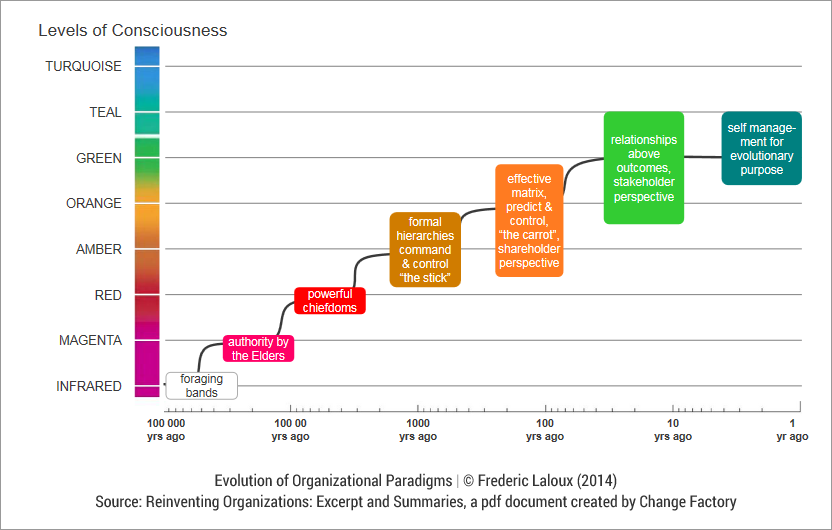
Download Frederic Laloux “Reinventing organizations”: excerpt and summaries, by Change Factory (pdf; 32pp)
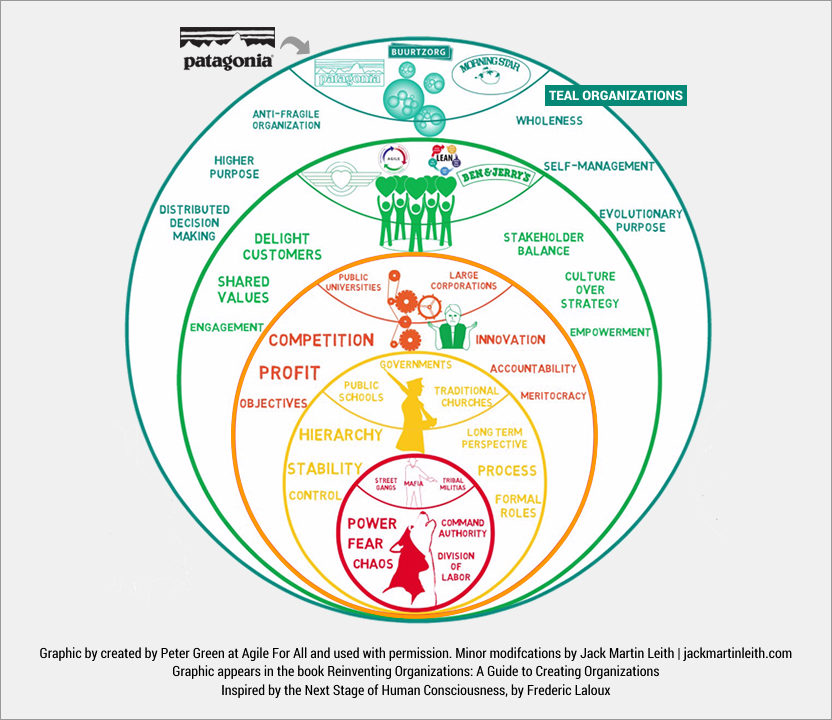
The original graphic comes from a video overview of Reinventing Organizations created by Peter Green at Agile For All. Warm thanks to Peter for his permission to include it here.
Some quotes about Laloux’s Teal
We urge you to not take everything you read or hear (especially when it comes to management stuff) too literally. We feel that this is especially true for everything teal related.
Use the theories, models, case studies and best practices as sources of inspiration, but don’t forget to critically assess them. The danger is that you try to become more teal than real.
Source: Bursting the Bubble. Teal Ain’t Real, by Corporate Rebels.
There’s much you write about that I agree with. I’ve used the term “Teal” and an evolutionary perspective, because I find it useful for readers to understand that we are not just talking about a bunch of cool new practices, but really about a whole new perspective on organizations, on people and on work. (That’s why, if you simply take some of the “Teal” practices and inject them in an organization with the main motivation and hope that it will help you improve profits beat competition — i.e. with an “Orange” mindset — it fails).
I also think this evolutionary perspective helpful for readers to understand that if they can’t find themselves in traditional management practices anymore, it’s not because they are somehow misfits, but because they simply look at the world in different ways.
That said, now that the book is out, I rarely use the word Teal to talk about the new type of management that some people long for.
When someone tells me “I want my organizations to be Teal”, I stop them and ask them: What do you really want? You don’t want to be a concept! What is it that you no longer want to do, that hurts your integrity? What is it that calls you?”
That’s the real conversation I feel we need to have.
Source: Frederic Laloux Responds to “Bursting the Bubble – Teal Ain’t Real”, by Frederic Laloux, on Enlivening Edge website.
While there may or may not be merit in the many prescriptions that Laloux offers, it’s very hard to get to them. The intellectual trick at the heart of this book means the core of Laloux’s practice is buried under many layers of good intentions, New Age beliefs, and polemical spin. It’s all very unfortunate because the question at the heart of Laloux’s book is a timely one. Alas, we will have to look elsewhere for a convincing exploration.
Source: Is Teal The New Black? Probably Not, A review of Federic Laloux’s Reinventing Organizations, by Zaid Hassan, on Social Laboratories website (link removed following a security warning) | Frank Visser comments on Zaid Hassan’s review here
Read more about Frederic Laloux and Teal organizations
CritiquesCreative entropy — a killer problem with Laloux’s evolutionary purpose, by Tom Nixon, on Medium
A critique of the ‘subtle hierarchism’ of the Teal Organizations concept in the book ‘Reinventing Organizations’, by Michel Bauwens, on P2P Foundation website
Frederic Laloux and His Critics: Finding Middle Ground Between Skepticism and Belief, by Frank Visser, on Integral World website
Case studies
Going teal — two stories from two agencies, by Lisa Gill, on Medium
Resources
Reinventing Organizations—official website
Reinventing Organizations wiki | Extensive Creative Commons resources for those who want to create a Teal organization
How various developmental theories correspond
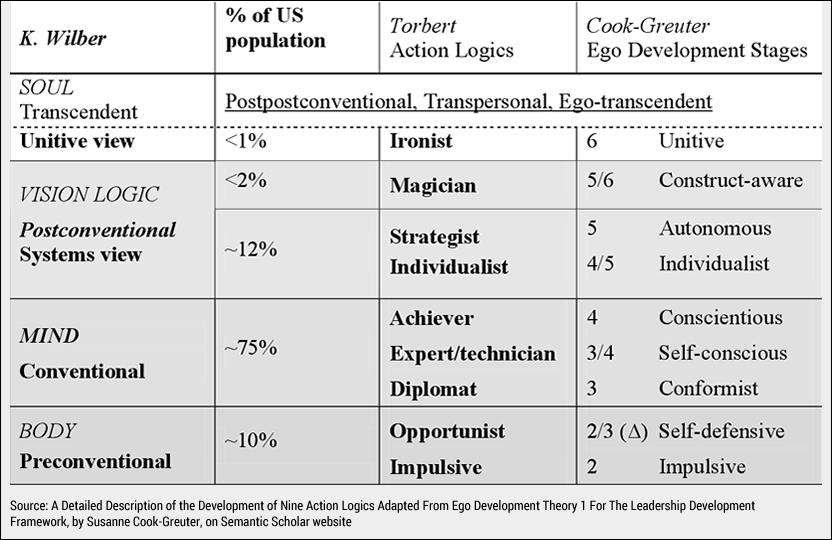
Source: A Detailed Description of the Development of Nine Action Logics Adapted From Ego Development Theory 1 For The Leadership Development Framework, by Susanne Cook-Greuter, on Semantic Scholar website (paywalled).
The Spectrum of Consciousness
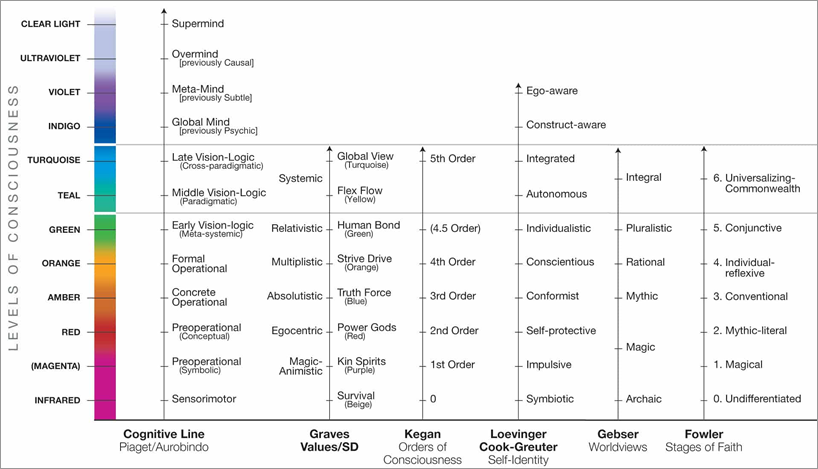
The originator of this table is unknown but it is derived from the work of Ken Wilber (view). Other versions [2] [3] are in circulation, with variations in the researchers appearing on the horizontal axis.
People cited in this and related versions
Jean Gebser (pdf)
Francis Richards
Francis Asbury Richards is an American psychologist recognized for his collaboration with Michael Lamport Commons in developing the Model of Hierarchical Complexity (MHC) in the early 1980s. Source: Metamoderna.
This model provides a framework for assessing the complexity of behaviors, such as verbal reasoning and other cognitive tasks, by quantifying their hierarchical organization. Source: Wikipedia.
Richards co-edited the book “Beyond Formal Operations: Late Adolescent and Adult Cognitive Development,” which examines cognitive development during late adolescence and adulthood. Source: Amazon.
Additionally, he co-authored the article “Organizing Components into Combinations: How Stage Transition Works,” published in the journal Cognitive Development, which explores the mechanisms of stage transitions in cognitive development. Source: Springer Link.
While specific details about Richards’ personal life and career are limited in the available sources, his contributions to developmental psychology, particularly through the MHC, have been influential in understanding cognitive development beyond Piaget’s formal operations stage. Source: ChatGPT.
Further reading
This website
How our worldviews are evolving
Search the site
Not case sensitive. Do not to hit return.